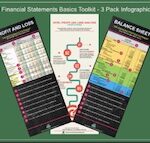Hotel Performance Basics Beginners Struggle with
Do you know what part of hotel financial performance analysis beginners struggle with the most?
Are you a victim of this?
The biggest mistake beginners make is to jump into the hotel Profit and Loss Statement straightaway.
And attempt to analyze revenue, expenses and bottom line.
Without being completely clear about concepts that are the foundation to performance analysis.
You could call these concepts “learning maps”.
Without a good grip of these learning maps, no hotel financial performance analysis can be effective.
Grab this EXCEL Spreadsheet
Don’t miss our 5 Killer Hotel KPIs Dashboard
Get this exclusive Excel Template that you can customize to create your own 5 Killer Hotel KPIs Dashboard
And it applies to the hotel profit and loss statement the most.
How about you?
Are you clear about them?
Understanding these learning maps first will lend solid strength to your performance analysis.
In this 6 part series, I will take you through key learning maps for an effective hotel profit and loss statement analysis.
This Part 1 of 6 of the series will be about Conceptual Learning Maps.
Let us dive straight in.
Why Learning Maps for Hotel Profit and Loss Statement?
You may be thinking in your mind: why learning maps and what are these maps all about.
Great thoughts.
Let me clear the air right away.
Hotel Financial Statements are documents with a wealth of information in them.
However, it is important to realize that we must first step back and take a big picture overview.
I mean, look at the environment surrounding a hotel profit and loss statement.
Know some foundational elements first.
These foundational elements can be called learning maps.
What is the function of a map?
A map allows you to plan out a route to reach a particular destination.
Without a map, you will find it difficult to plan your journey.
You may face questions like:
- What is the fastest route to the destination?
- What is the best route to the destination? (fastest may not necessarily be the best!).
- What is the safest route to the destination?
And so on.
Similarly, it is critical to plan out your analysis of the hotel profit and loss statement.
Answer questions like:
- What factors you must consider before beginning to read the financial statement?
- Which are elements surrounding the statement that will make your analysis most effective.
So on and so forth.
Let us come back to the learning maps for a hotel profit and loss statement.
Learning Maps and the Performance Statement
The hotel profit and loss statement is a performance statement.
Unlike a hotel balance sheet which is a financial position statement.
Both are key financial statements.
However, both perform different functions.
As a performance statement, the hotel profit and loss statement mainly deals with 3 elements:
- revenue
- expenses
- profit (also known as bottom line)
But long before you begin to dive into these 3 elements, you must deal with learning maps first.
And more specifically conceptual learning maps.
Concepts that underpin what a hotel profit and loss statement is all about.
Let us see what these conceptual learning maps are.
Context Learning Maps in the Hotel Performance Statement
The first conceptual learning map you must understand is context.
Context is key in a hotel profit and loss statement.
What do I mean by context?
By context, I mean you must know a bit of background of the profit and loss statement.
You look puzzled.
Let me clarify.
Look at the Profit and Loss Statement of Paradise Hotel shown above.
Here, actual revenue, expenses and profit are shown for the period ended 31st December 2019.
Performance - Which Part of the Year are you in?
One of the first things to be clear about in a hotel Profit and Loss Statement is the answer to this question:
Which part of the year are you in?
This may seem like an obvious thing but the implications may be far beyond what we generally accept, so bear with me.
You could say that it is the first conceptual learning map to understand.
This is context we are talking about.
Why is it important to know which part of the year we are in?
After all, we are in the hotel operation day in and day out.
We know that already.
In reality, you may not have realized a few things.
Things which, knowing that information, may have empowered you with.
First, this information may be essential to how you can influence the performance of the hotel going forward.
Let me explain.
Current Month Performance in a Hotel Profit and Loss Statement
Say, you are analyzing and discussing the performance of the month of February in a year.
Would it make sense to you if I said that is totally different from being in the month of November in a year?
I don't just mean that the month is different.
I mean something much more powerful linked to a month.
In the month of February, essentially you are looking at only 1/6th of the year (16%).
This means you have 10 out of 12 months of the year to correct and set right your variances.
You could be behind your budget and forecast in February.
But it may not matter since you can make up in the balance 10 months of the year.
This is a powerful conceptual learning map element often ignored by beginners (and some non-beginners too!)..
The hotel industry is a seasonal business.
Say you have fallen behind in revenue and profit in a particular month.
You can easily make up depending on the number of months left in the year.
November is exactly the opposite.
There is very little you can do to set right negative variances in revenue and profit.
This is because you have only one more month to go for the year to be over.
The next time you are analyzing your hotel profit and loss statement, before you do anything, do this.
Be clear about implications of which part of the year you are in.
Go back to the Paradise Hotel Profit and Loss Statement above.
Here, a comparison to budget and last year are available.
There are two important elements to those numbers as follows:
- Current Month revenue, expenses and profit and
- Year To Date revenue, expenses and profit i.e., for the actual number of months completed in the current year
Why Current Month & Year To Date?
Why is it important to separate current month and year to date figures for revenue, expenses and profit?
Current month results only reflect the performance of the hotel for the particular month.
These can be analyzed in isolation.
We will revisit this shortly.
Let us now move on to the second conceptual learning map.
And that is Year To Date.
Year To Date Performance in a Hotel Profit and Loss Statement
Let us look at the Paradise Hotel Profit and Loss Statement from a Year-To-Date angle.
The Year To Date Mirage
The Year To Date number in a hotel profit and loss statement is a sort of mirage.
Things are not exactly what they appear to be!
What do I mean by that?
For starters, the same questions we asked for the current month applies to year to date too.
- Which part of the year are you in?
- Are you at the beginning of the year, in the middle or at the end of the year?
The same comment as current month applies here too.
If you are at the beginning of the year, you have an opportunity to fix negative variances.
This is because you have a majority of the year still left.
But hang on!
That is not the mirage!
The mirage happens because of the way the year to date numbers are derived.
Let me explain in a non-technical way.
Let us say you are looking at the Profit and Loss Statement for the month of February 2020.
In this case, your year to date will be for the two months of January and February 2020.
So, the calculation is done as below:
- First, you take the current month results for January 2020
- Since January is the first month, current month and Year-To-Date are the same!!
- Then you take the year to date at the end of January 2020 and
- Add the current month of February 2020 to it
- To get the year to date of February 2020.
Here is the mirage!
You actually CANNOT do anything to the year to date number.
You ONLY CAN do something to each current month results.
Let me say that again in a different way.
The Year To Date number is ONLY adding individual Current Month numbers.
Thus, all your action on variances must take place in individual months.
This is why Current Month is the most powerful period you should be looking at.
So, there you are.
Two conceptual learning maps - current month and year to date.
Maps that define context in a hotel profit and loss statement.
Learning Maps you should be in grips with much before any analysis.
And you will see how understanding the conceptual learning maps will make your analysis powerful.
What did you think of the conceptual learning maps of current month and year to date?
Do you have a good understanding of them?
Write in the comments below what you think.
Next Week: The Revenue Learning Map in a Hotel Profit and Loss Statement
In Part 2 of this 6 part series, we will visit the Revenue Learning Map of a Hotel Profit and Loss Statement.
Stay tuned!
Action Steps You Can Take Right Now
STEP 1
Examine your hotel's profit and loss statement with fresh eyes before doing any analysis.
STEP 2
Which part of the year are you in right now? What does the current month results show?
STEP 3
How many months of results are included in your hotel's year-to-date?
STEP 4
Are you focusing on the individual months for actions to be taken?
STEP 5
How many months are left in the year for you to take corrective action?
Related Posts
Sign Up for More Tips, Strategies and Secrets
Sign up to the Financial Skills Building Newsletter for more tips, strategies and secrets straight to your inbox.
14






